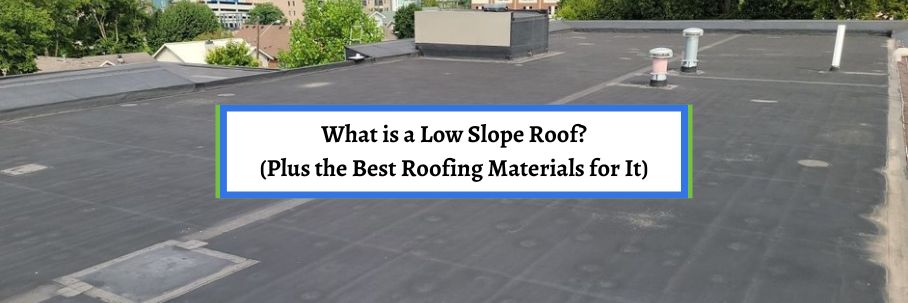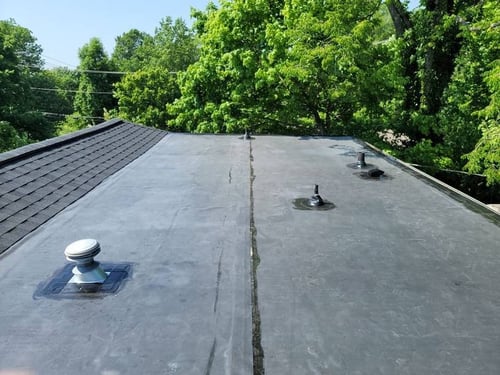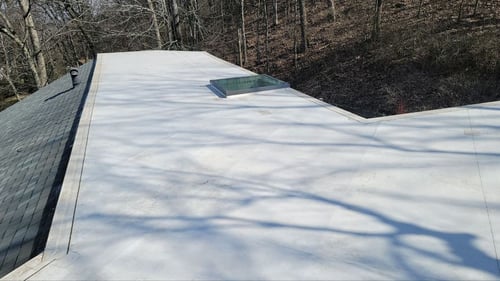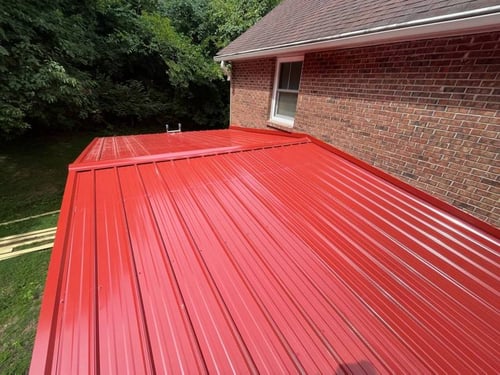What is a Low Slope Roof? (Plus the Best Roofing Materials for It)

Residential roofs come in all shapes and sizes, from simple up-and-overs to complex roofs with multiple facets at different angles. While there are a wide variety of roofs, a low slope roof is a little different from the rest.
Low slope roofing isn’t as common in residential roofing, which is why homeowners don’t know much about it. So, what is a low slope roof, and what makes it unique?
For over 30 years, the team at Bill Ragan Roofing has taken pride in helping homeowners understand the ins-and-outs of their roofing project. That’s why I’ll break down low slope roofing by starting with the basics.
This article answers the following questions:
- What is roof pitch?
- What is a low slope roof?
- Why can’t you install shingles on a low slope roof?
- What are the best roofing materials for a low slope roof?
What is roof pitch?
To understand what’s considered low slope, you need to know about roof pitch. Roof pitch is simply the steepness (angle) of a roof calculated by the number of inches/feet it rises vertically for every 12 inches/feet it extends horizontally.
 (Pitch reader on an asphalt shingle roof)
(Pitch reader on an asphalt shingle roof)
For example, a roof with a 4/12 pitch will be 4 inches (or feet) up for every 12 inches (feet) out. A roof’s pitch impacts everything, from the cost, materials, labor, and time to complete a roof replacement.
Also, there’s no reason to risk your safety to figure out your roof’s pitch. You’ll learn what it is after a roof inspection from a local roofing contractor, plus they have the right tools to do it correctly.
What is a low slope roof?
A roof is considered low slope when the pitch is below a 2:12. This means any roof that's less than 2 vertical units (inches or feet) up for every 12 horizontal units out is considered low slope or flat.
 (Low slope roof area on an asphalt shingle roof)
(Low slope roof area on an asphalt shingle roof)
A roof with a low slope doesn’t have enough pitch for water to drain normally down to the gutters. Because of this, it needs a certain type of roofing material.
Unfortunately, this disqualifies the commonly used asphalt shingles.
Why can’t you install shingles on a low slope roof?
Per shingle manufacturers’ installation instructions, a low pitched (or flat) roof is not steep enough for shingles to be installed. This is simply because asphalt shingles aren’t meant to handle water ponding on a low pitch or flat roof.
 (Asphalt shingles installed on a 1:12 low slope roof)
(Asphalt shingles installed on a 1:12 low slope roof)
Sitting water not only creates a leak if nail pops or other problems are in the area but also shortens asphalt shingles’ lifespan. A reputable roofer knows not to install shingles on a roof with a 2:12 pitch or less, but you’ll find companies that do to bring down costs.
This is strictly against the installation instructions, which means the manufacturer won’t warranty the area. The low slope section also won’t be up to code per code R905.2.2 of the 2018 International Residential Code.
What are the best roofing materials for a low slope roof?
If shingles can’t be installed on low slope roofs, what roofing materials can? While there are multiple options, the two best are membrane roofing and metal roofing.
Membrane roof systems
The most common option for low slope roofs is membrane roof systems. Membrane roofing comes in 5-foot, 10-foot, or 20-foot wide sheets of rolled synthetic, water-repellent membrane.
The most popular types of membrane roof systems are EPDM, PVC, and TPO.
EPDM membrane
EPDM roofing membrane (ethylene propylene diene monomer) is a synthetic rubber black membrane mainly installed on commercial and medical facilities. However, EPDM is becoming more and more popular in residential roofing.

The downside to getting the black membrane is that it absorbs heat, which can make bedrooms or living spaces hot during the summer months. The good thing is that it doesn’t get as dirty as white membranes, so you don’t have to worry about the aesthetics as time passes.
A white version is out now, but black is the main color used. Just make sure to consider the heat absorption for the room below when making your final decision.
The biggest benefit of an EPDM roofing membrane is its durability, which I like to say is almost like having a bulletproof rubber roof. This durability means you can expect to get around 25 to 30 years out of a fully adhered 0.060-thickness EPDM roofing membrane.
PVC membrane
PVC roofing membrane (polyvinyl chloride) is a single-ply white membrane used in commercial and residential roofing. As I mentioned earlier, the white reflects heat instead of absorbing it.

That’s why PVC is a great option for a low slope roof over living spaces or buildings looking for energy efficiency in the hot months. But remember, the white membrane gets dirty over time and can look unsightly if you can see it.
The “dirtiness” won’t affect a PVC roofing membrane’s functionality, so don’t worry about the look if aesthetics aren’t a big deal or if you can't see the roof. PVC isn’t as durable as EPDM, but you should still get around 25 years out of it if it’s properly installed.
TPO membrane
TPO roofing membrane (thermoplastic polyolefin) is also a single-ply white membrane used in both commercial and residential roofing. PVC is very similar to TPO to the point where an untrained eye can’t tell the difference.

It has the benefit of reflecting heat due to the white membrane. The only big difference is that a PVC membrane is more flexible than a TPO membrane.
But even with this difference, you can still expect to get around 25 years out of a TPO membrane as long as it’s installed properly.
Metal roofing systems
Both metal roof systems can be installed on a low pitch roof, but they aren’t meant to withstand ponding water. So, they shouldn’t be installed on a completely flat roof unless your roofing contractor builds it up to provide drainage.
 (Example of a flat roof being built up to add a pitch)
(Example of a flat roof being built up to add a pitch)
However, metal roofing is still a great option for a low slope roof for its durability and high curb appeal.
Standing seam metal roofing
A standing seam metal roof is a series of panels locked together at the seams (ribs) or seamed mechanically to allow the metal to expand and contract freely. It's a great choice for a low slope roof because of its multiple color options, durability, and longer lifespan.
.jpg?width=500&height=300&name=Blog%20Images%20(4).jpg)
You also don’t have to worry as much about the room underneath, but you will be able to hear rain hit the panels. A properly installed standing seam metal roof should last 30 years, with the potential to get up to 50 years in ideal conditions.
Exposed fastener metal roofing
An exposed fastener metal roof (also called screw down) is fastened down to the roof decking through the panels. The fasteners (screws) are exposed, which is where it gets the name.

Unlike a standing seam metal roof, it can’t move freely when expanding and contracting because it’s screwed directly through the metal. This lack of expansion qualities causes the washers to wallow out, which backs the screws out of the panels over time.
Because of this and the lack of Kynar 500, an exposed fastener metal roof to last around 30 years. You can still get this type of metal roof over a low slope roof, but you’ll have to pay to replace the screws when they get wallowed out to avoid roof leaks.
However, I always recommend a standing seam metal roof over any living space for residential purposes.
How much does a low slope or roof replacement cost?
Now you know what a low slope roof is, why asphalt shingles can’t be installed on it, and the best roof systems for a low slope roof. The roofing material you choose is completely up to you, but remember to consider the room underneath and if you can see it from a window.
While knowing all this information is great, there’s a huge question left to be answered. This, of course, is how much it costs to replace a low slope roof.
Pricing is the biggest concern homeowners have about any roof related project. That’s why I wrote another article breaking down the budget you'll need for your low slope roofing project.
Check out How Much a Flat Roof Replacement Costs to learn how much you can expect to pay for a new flat or low slope roof.


